By Frank Palmer.
During the Napoleonic Wars many prisoners were taken on both sides. Those taken by the British were shipped back to Britain and held in prison hulks and prisons through out the land. Dartmoor Prison was built for this purpose.
In 1803 it was decided to set up “parole towns”. Only officers were eligible for this concession which meant living with families in the parole towns; they were sworn on oath to behave decently and stay within the town’s boundaries; never-the-less some did escape back to France; afterwards only Scottish and Welsh border and some Midland and West Country towns were used. Captains and above paid 10/6d a week, others 8/9d. for board and keep.
Many French prisoners were taken during the Peninsular War (1808-14) and in 1811 over 300 were sent to Owestry in Shropshire near the Welsh border. On the 6th. April 1812 General Arnaud Philippon surrendered to Wellington at Badajoz in Spain and was sent to Owestry. On July 8th. he escaped together with Lt. Garnier. Later it was reported that both men were back in France. The escape was made possible with the assistance of a local miller, one James Robinson, who hid the two men amongst sacks of flour, once clear of Owestry they exchanged the cart for a coach and horses and made for Rye.
At Rye they arrived at the Red Lion Inn and were received by the licensee John Hughes who was also the Post Master. He was expecting the General and Garnier, being party to the plot.
News of the escape and their descriptions were circulated. Philippon was 6′ tall, thin, with a scar over his eye, dressed in a grey coat and blue great coat. Garnier was about 5’6″ tall, thin, and pale, dressed in a blue coat and brown great coat.
Two officers, Vickery and Peakes, from the Bow Street Office traced Philippon to Rye but were too late to prevent him and Garnier being taken over the Channel to France.
On the 12th. July an open boat was seen being rowed into Rye early in the morning. On board were James Robinson with William Hatter and William Turner, both Rye men, and described as smugglers.
Robinson escaped but was traced to the Red Lion, his boots were wet with sea water. These three and Hughes were arrested and taken to Bow Street for further examination.
On August 14th. 1812, at the Sussex Assizes held at Horsham, Robinson, Hughes and Hatter were found guilty of conspiracy to aid the escape of Philippon and Garnier. Turner being acquitted. They were sentenced to two years in Horsham Jail but the Judge directed that Robinson and Hughes, before the expiration of one month, were to stand in the pillory at Rye “as nigh as possible to the spot from whence the French Officers were supposed to have embarked in order that the prisoners might, from their elevated situation have an opportunity of observing the coast of the country they had so much favoured”.
It is believed that the escape was funded by another prisoner at Oswestry, Prince d’ Arenberg.
The pillory was abolished in England in 1837 but had only been used for perjury since 1815.
A transfer illustration of the old pillory, which is housed in Rye Town Hall, was used to decorate certain pieces of Goss china. It was commissioned by John Neeve Masters, the Goss agent for Rye & Winchelsea, and sold at his shop in Rye High Street.
Bow Street Runners were the first regular police and detective force organized in the mid Eighteenth century under the chief magistrate at Bow Street, London. Several of them became specialists in certain branches of their work, which could be anywhere in the U.K. and even on the Continent. Their principal function was the apprehension of criminals but also security at the Bank of England and Royalty protection amongst many other duties.
Vickery, who came to Rye, was employed by the Post Office for investigations of fraud and security. When out of London, Bow Street Runners were required to apply to a magistrate to back the warrant but were warned by the chief magistrate at Bow Street, before being sent to arrest smugglers, not to apply to one of the magistrates at the Cinque Ports, lest the object you have in view be thwarted by the party giving information to the persons accused. It was well known that some country justices were dishonest and in league with smuggling gangs.
Information from :-
Shropshire Records and Research Service.
‘Bye-Gones’ January 1879.
John Pryce Jones. Local History.
A. Babbington “A House in Bow Street”
